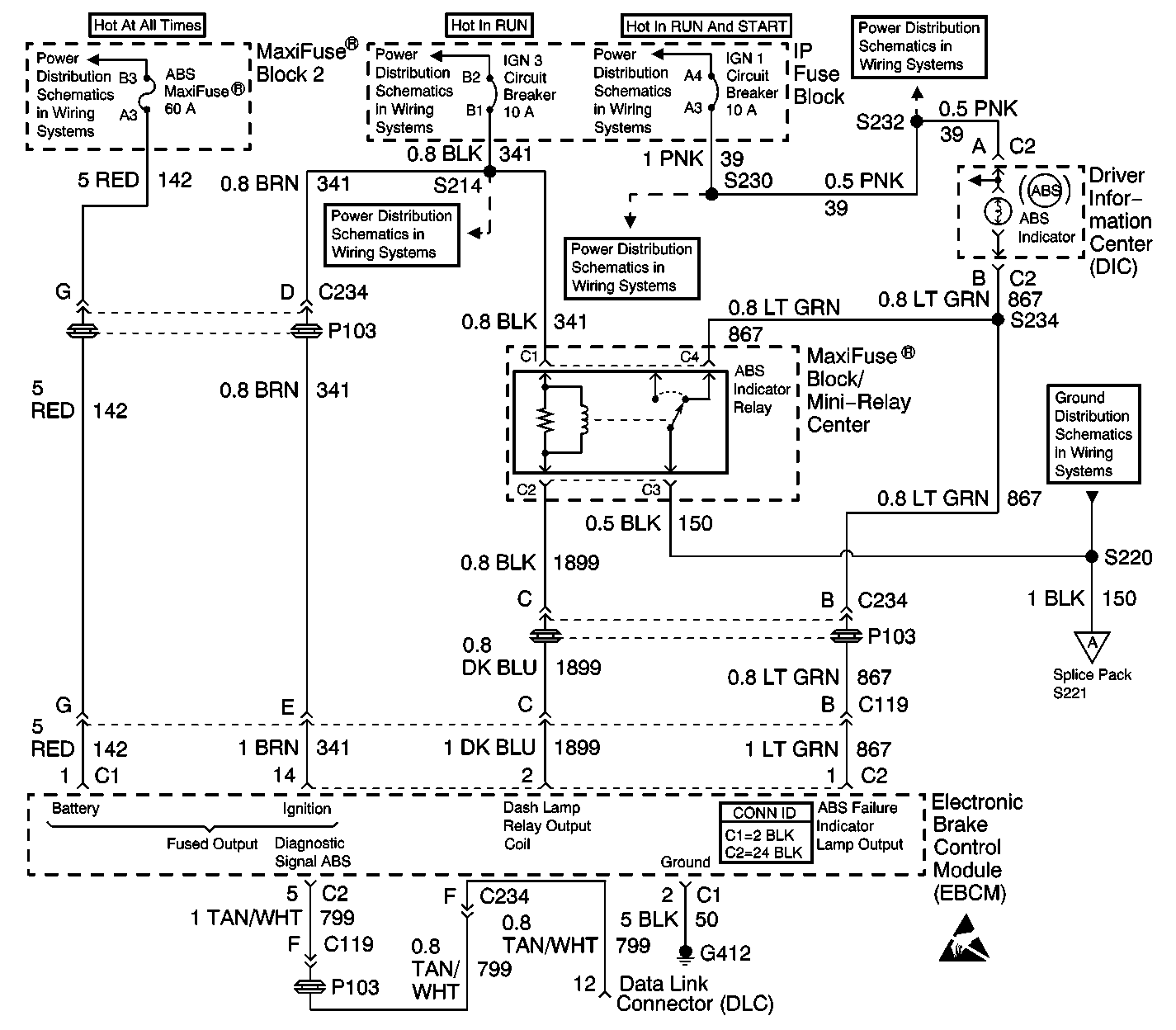
Circuit Description
The amber ABS indicator lamp operates in two modes; normal and backup. In the normal mode, ignition voltage is supplied to the ABS indicator lamp bulb through the IGN SW fuse. Once the ignition is turned on or the vehicle is started the EBCM energizes the ABS indicator lamp relay (normally closed) and ground path for the light through the relay is opened. The EBCM also illuminates the ABS indicator lamp for a 2 second bulb check by suppling ground through connector C2, terminal 1, If the EBCM senses a failure and a DTC is set, it will illuminate the lamp in this manner. In the backup mode, the ABS telltale relay circuit will ensure that the ABS indicator lamp is illuminated if the 24-way connector is disconnected or poorly seated, or if certain EBCM internal failures during normal operation. If either of these conditions occur, the ABS indicator lamp relay closes, which creates an alternate ground path to the ABS indicator lamp circuit through terminal B8 and terminal A7 of the EBCM. This system ensures that the ABS indicator lamp will always be turned on if the following conditions exist:
| • | Open or high resistance in CKT 867 (between S113 and the instrument cluster). |
| • | The EBCM is faulty |
Diagnostic Aids
If the ABS indicator lamp is off always with no DTCs set (never turns on at bulb check, with the vehicle started or with the ignition switch in the RUN position), an open or high resistance in the lamp circuit is present between the instrument panel and the EBCM. Also check for an open instrument panel fuse or an open bulb.
Test Description
The numbers below refer to the steps in the diagnostic table:
-
This step checks for normal operation of the ABS indicator lamp.
-
This step manually (with fused jumper) turns on the ABS indicator lamp by bypassing the ABS indicator relay.
-
This step checks for a short to ground in CKT 1899.
Step | Action | Value(s) | Yes | No |
|---|---|---|---|---|
1 | Was the Diagnostic System Check performed? | -- | Go to Step 2 | Go to Diagnostic System Check |
Does the ABS indicator lamp turn on? | -- | Go to Step 6 | Go to Step 3 | |
Jumper terminal C4 of the relay center harness connector to ground. Does the ABS indicator lamp turn on? | -- | Go to Step 4 | Go to Step 8 | |
4 | Using a J 39200 , measure the resistance between the relay center harness connector terminal C3 and ground. Is the resistance measurement within the specified range? | 0-2 ohms | Go to Step 5 | Go to Step 11 |
Using a J 39200 , measure the resistance between the relay center harness connector terminal C2 and ground. Is the resistance measurement equal to the specified value? | OL (infinite) | Go to Step 13 | Go to Step 12 | |
6 |
Inspect CKT 1899 for damage that could result in a short to ground. Repair damage if evident. Is the ABS indicator lamp off constantly? | -- | Go to Step 7 | Go to Diagnostic Aids. |
7 | Replace the EBCM. Refer to Electronic Brake Control Module Replacement . Is the repair complete? | -- | Go to Diagnostic System Check | -- |
8 | Check for an open ABS indicator lamp. Is the ABS indicator lamp open? | -- | Go to Step 10 | Go to Step 9 |
9 | Repair the open or the high resistance in CKT 867. Refer to Wiring Repairs in Wiring Systems. Is the repair complete? | -- | Go to Diagnostic System Check | -- |
10 | Replace the ABS indicator lamp. Is the repair complete? | -- | Go to Diagnostic System Check | -- |
11 | Repair the open or the high resistance in CKT 150. Refer to Wiring Repairs in Wiring Systems. Is the repair complete? | -- | Go to Diagnostic System Check | -- |
12 | Repair the short to ground in CKT 1899. Refer to Wiring Repairs in Wiring Systems. Is the repair complete? | -- | Go to Diagnostic System Check | -- |
13 | Replace the ABS indicator relay. Is the repair complete? | -- | Go to Diagnostic System Check | -- |
